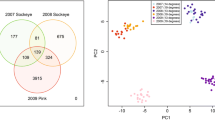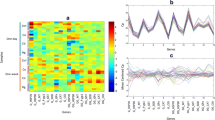Abstract
The extent to which humans and wildlife are exposed to toxicants is an important focus of environmental research. This work has been directed toward the development of molecular indicators diagnostic for exposure to various stressors in freshwater fish. Research includes the discovery of genes, indicative of environmental exposure, in the Agency's long-established aquatic toxicological organism, the fathead minnow (Pimephales promelas). Novel cDNAs and coding sequences will be used in DNA microarray analyses for pattern identification of stressor-specific, differentially up- and down-regulated genes. The methods currently used to discover genes in this organism, for which few annotated nucleic acid sequences exist, are cDNA subtraction libraries, differential display, exploiting PCR primers for known genes of other members of the family Cyprinidae and use of degenerate PCR primers designed from regions of moderate protein homology. Single or multiple genes noted as being differentially expressed in microarray analyses will then be used in separate studies to measure bioavailable stressors in the laboratory and field. These analyses will be accomplished by quantitative RT-PCR. Moving from analysis of single gene exposures to the global state of the transcriptome offers possibilities that those genes identified by DNA microarray analyses might be critical components of dynamic biological systems and networks, wherein chemical stressors exert toxic effects through various modes of action. Additionally, the ability to discriminate bioavailability of stressors in complex environmental mixtures, and correlation with adverse effects downstream from these early molecular events, presents challenging new ground to be broken in the area of risk assessment.
Similar content being viewed by others
References
APHA. (1998). Standard Methods for the Examination of Water and Wastewater, 20th edn., American Public Health Association.
ASTM. (1998). American Society for Testing and Materials Annual Book of ASTM Standards Biological Effects and Environmental Fate; Section 11: Water and Environmental Technology. 11.05. American Society for Testing and Materials.
Environment Canada. (1992). Biological Test Method: Tests of Larval Growth and Survival Using Fathead Minnows. Environmental Protection Series.
Freeman, W.M., Walker, S.J. and Vrana, K.E. (1999). Quantitative RT-PCR: pitfalls and potential. Biotechniques 26, 112-15.
Hamadeh, H.K., Bushel, P., Paules, R. and Afshari, C.A. (2001). Discovery in toxicology: mediation by gene expression array technology. J. Biochem. Mol. Toxicol. 15, 231-42.
Hamadeh, H.K., Bushel, P.R., Jayadev, S., DiSorbo, O., Bennett, L., Li, L.P., Tennant, R., Stoll, R., Barrett, J.C., Paules, R.S., Blanchard, K. and Afshari, C.A. (2002a). Prediction of compound signature using high density gene expression profiling. Toxicol. Sci. 67, 232-40.
Hamadeh, H.K., Bushel, P.R., Jayadev, S., Martin, K., DiSorbo, O., Sieber, Bennett, L., Tennant, R., Stoll, R., Barrett, J.C., Blanchard, K., Paules, R.S. and Afshari, C.A. (2002b). Gene expression analysis reveals chemical-specific profiles. Toxicol. Sci. 67, 219-31.
Lattier, D.L., Reddy, T.V., Gordon, D.A., Lazorchak, J.M., Smith, M.E., Williams, D.E., Wiechman, B., Flick, R.W., Miracle, A.L. and Toth, G.P. (2002). 17α-Ethynylestradiol induced vitellogenin gene transcription quantified in fathead minnow (Pimephales promelas) adult male livers, embryo larvae and gills. Environ. Toxicol. Chem. 21, 2385-93.
Liang, P. (2002). A decade of differential display. Biotechniques 33, 338-46.
Lobenhofer, E.K., Bushel, P.R., Afshari, C.A. and Hamadeh, H.K. (2001). Progress in the application of DNA microarrays. Environ. Health Perspect. 109, 881-91.
Mount, D.I. (1968). Chronic toxicity of copper to fathead minnows (Pimephales promelas Rafinesque). Water Res. 2, 214-23.
Norberg, T.J. and Mount, D.I. (1985). A new fathead minnow (Pimephales promelas) subchronic toxicity test. Enviro. Toxicol. Chem. 4, 711-18.
OECD. (1984). Guidelines for testing of chemicals; Section 2, Effects on Biotic Systems. Organization for Economic Cooperation and Development.
OECD. (1992). Guidelines for testing of chemicals; Section 2, Effects on Biotic Systems. Organization for Economic Cooperation and Development.
Oliver, B., Parisi, M. and Clark, D. (2002). Gene expression neighborhoods. J. Biol. 1, 4.1-4.3.
Pickering, Q.H. and Lazorchak, J.M. (1995). Evaluation of the robustness of the fathead minnow, Pimephales promelas, larval survival and growth test, US EPA method 1000.0. Environ. Toxicol. Chem. 14, 653-9.
Pickering, Q.H., Lazorchak, J.M. and Winks, K.L. (1996). Subchronic sensitivity of one-, four-, and seven-day-old fathead minnow (Pimephales promelas) larvae to five toxicants. Environ. Toxicol. Chem. 15, 353-9.
Rajeevan, M.S., Ranamukhaarachchi, D.G., Vernon, S.D. and Unger, E.R. (2001a). Use of real-time quantitative PCR to validate the results of cDNA array and differential display PCR technologies. Methods 25, 443-51.
Rajeevan, M.S., Vernon, S.D., Taysavang, N. and Unger, E.R. (2001b). Validation of array-based gene expression profiles by real-time (kinetic) RT-PCR. J. Mol. Diagn. 3, 26-31.
Ramdas, L., Coombes, K.R., Baggerly, K., Abruzzo, L., Highsmith, W.E., Krogmann, T., Hamilton, S.R. and Zhang, W. (2001). Sources of nonlinearity in cDNA microarray expression measurements. Genome Biol. 2, 0047.1-0047.7.
Rast, J.P., Haire, R.N., Litman, R.T., Pross, S. and Litman, G.W. (1995). Identification and characterization of T-cell antigen receptor-related genes in phylogenetically diverse vertebrate species. Immunogenetics 42, 204-12.
Sagerstrom, C.G., Sun, B.I. and Sive, H.L. (1997). Subtractive cloning: past, present, and future. Annu. Rev. Biochem. 66, 751-83.
Spellman, P.T. and Rubin, G.M. (2002). Evidence for large domains of similarly expressed genes in the Drosophila genome. J. Biol. 1, 5.1-5.8.
US Environmental Protection Agency. (1993). Methods for measuring the acute toxicity of effluents and receiving waters to fresh-water and marine organisms. Office of Research and Development.
US Environmental Protection Agency. (1994). Short-term methods for estimating the chronic toxicity of effluents and receiving waters to fresh water organisms. Office of Research and Development.
Walker, N.J. (2001). Real-time and quantitative PCR: applications to mechanism-based toxicology. J. Biochem. Mol. Toxicol. 15, 121-7.
Weitzman, J.B. (2002). Transcriptional territories in the genome. J. Biol. 1, 2.1-2.5.
Author information
Authors and Affiliations
Corresponding author
Rights and permissions
About this article
Cite this article
Miracle, A.L., Toth, G.P. & Lattier, D.L. The Path from Molecular Indicators of Exposure to Describing Dynamic Biological Systems in an Aquatic Organism: Microarrays and the Fathead Minnow. Ecotoxicology 12, 457–462 (2003). https://doi.org/10.1023/B:ECTX.0000003030.67752.04
Issue Date:
DOI: https://doi.org/10.1023/B:ECTX.0000003030.67752.04




